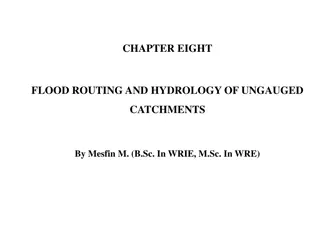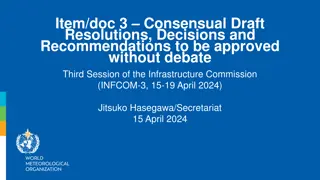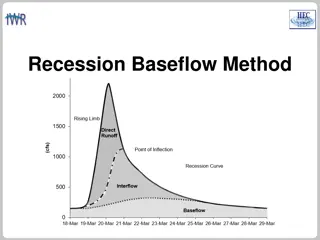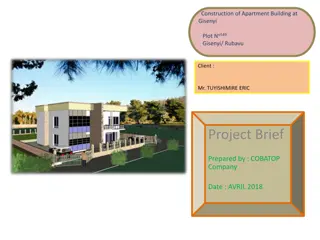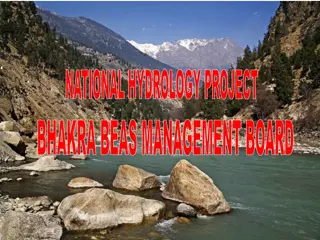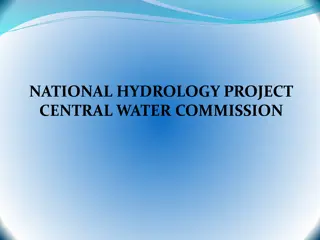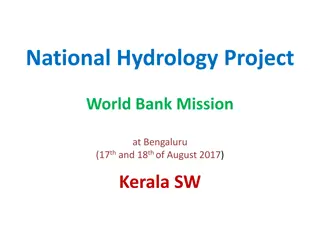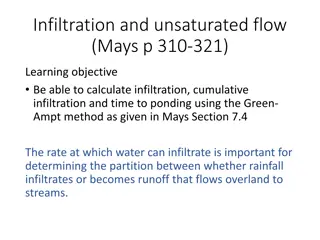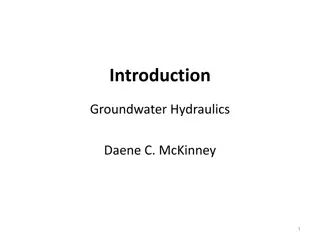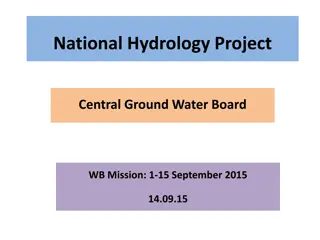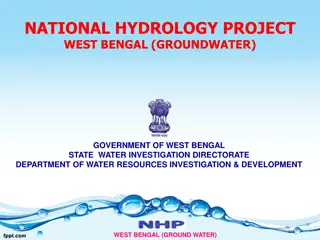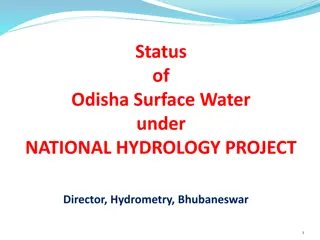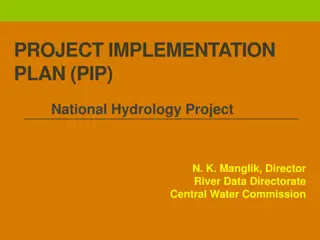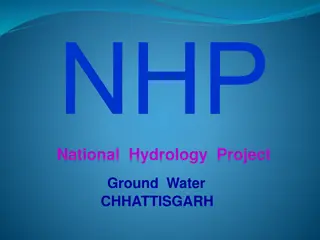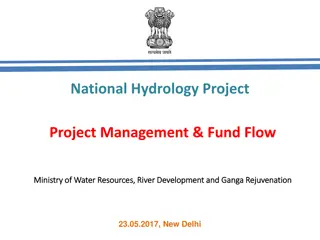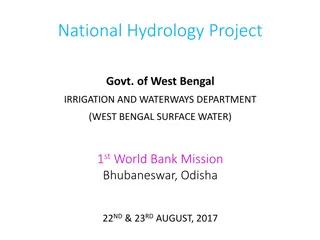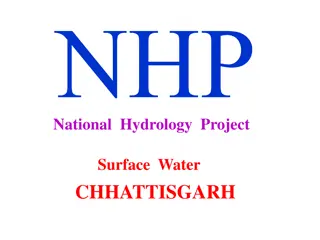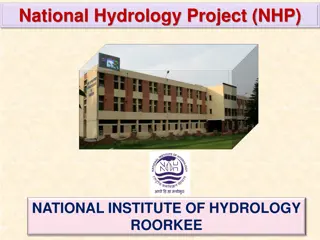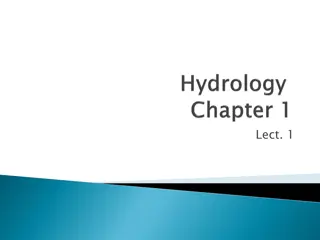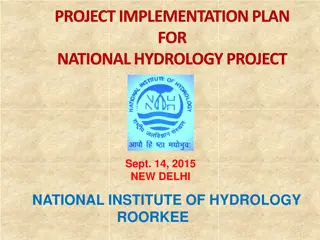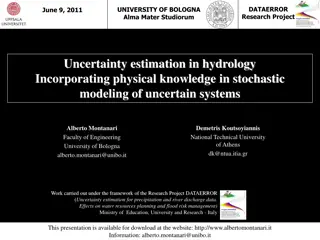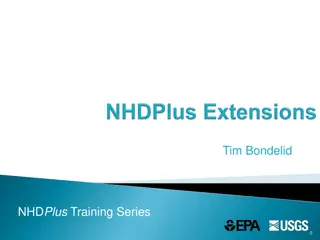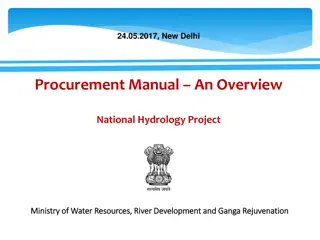Introduction to Flood Risk Assessment with HEC-FDA Overview
This presentation delves into flood risk assessment using HEC-FDA software, covering topics such as defining flood risk, components of uncertainty, consequences of flood risk, and methods to assess flood risk including hydrology, hydraulics, geotechnical, and economics. It explores the intersection
8 views • 39 slides
Overview of Physical Hydrology and Hydroclimatology
Physical Hydrology and Hydroclimatology, a science focusing on water properties, distribution, and circulation, covers topics such as mass balance, watershed transfer functions, reservoir sizing, storage-yield analysis, and optimal yield calculations. The concept of optimal yield highlights the impo
4 views • 10 slides
Flood Routing and Hydrology of Ungauged Catchments
This publication by Mesfin M. explores the important aspects of flood routing and hydrology in ungauged catchments. The content covers various topics related to analyzing and managing floods, especially in areas without monitoring stations. With detailed insights and informative slides, this resourc
4 views • 41 slides
Precipitation and Rainfall Patterns in Hydrology
Exploring the various forms of precipitation like rainfall, snowfall, hail, and sleet, this lesson delves into the complexities of precipitation forms, intensity classifications, types of rain gauges, and methods for correcting deficiencies in rainfall data. Through detailed descriptions and images,
1 views • 39 slides
Source Problems in Interstate Waters
Explore the intricate landscape of interstate water issues, from historical disputes like the Kansas v. Colorado case to modern conflicts such as Texas v. New Mexico. Delve into the intersecting realms of hydrology, law, and federal interests in managing water resources. Discover how the law navigat
0 views • 39 slides
Consensual Draft Resolutions and Decisions - INFCOM-3 Session
The document outlines proposed resolutions, decisions, and recommendations to be approved without debate at the Third Session of the Infrastructure Commission (INFCOM-3) happening from 15-19 April 2024. It includes updates on various guidelines, practices, and systems related to global observing, we
0 views • 14 slides
Runoff in Hydrology
Runoff in hydrology refers to surface water flow from precipitation and other sources in drainage basins. It plays a crucial role in stream flow and peak flood formation, influenced by factors like overland flow, interflow, and groundwater flow. This article explores the sources of runoff, including
3 views • 27 slides
The Recession Baseflow Method in Hydrology
Recession Baseflow Method is a technique used in hydrology to model hydrographs' recession curve. This method involves parameters like Initial Discharge, Recession Constant, and Threshold for baseflow. By analyzing different recession constants and threshold types such as Ratio to Peak, one can effe
0 views • 8 slides
Construction Project Brief: Apartment Building in Gisenyi, Rwanda
This project brief outlines the construction of an apartment building owned by Mr. TUYISHIMIRE Eric in Gisenyi, Rwanda. The project includes details such as project location, neighborhood context, project analysis, site analysis including hydrology and soils, and access to infrastructures such as wa
1 views • 6 slides
National Hydrology Project Progress Report
The National Hydrology Project in Rajasthan is making significant progress with successful trainings, establishment of SPMU, historical rainfall data digitization, and bid preparations for key components like Hydromet and SCADA systems. The project has received funds and made expenditures over the y
0 views • 17 slides
Bhakra Beas Management Board - National Hydrology Project Updates
This content provides detailed information about the National Hydrology Project under the Bhakra Beas Management Board. It covers aspects such as funds received, major procurement activities, physical progress, and status of bid documents for various packages. The content also includes key roles wit
0 views • 17 slides
National Hydrology Project by Central Water Commission
The National Hydrology Project led by the Central Water Commission focuses on river basin planning, dividing the country into 20 rivers encompassing major and composite basins. The proposed basin studies detail catchment areas, with phases of consultancy involving model development and scenario anal
1 views • 20 slides
Engineering Hydrology Course Overview and Great Salt Lake Evaporation Analysis
Engineering Hydrology course led by David Tarboton covers principles of hydrology, water balance concepts, and hydrologic modeling. The analysis of Great Salt Lake evaporation explores factors such as inflow, area, and precipitation to determine the average annual evaporation rate.
2 views • 18 slides
National Hydrology Project Overview and Progress Report
The National Hydrology Project, supported by the World Bank, aims to enhance water resource management in Kerala through strategic supervision and policy guidance. The State Level Project Steering Committee provides direction and support, while the SPMU oversees project implementation and major proc
0 views • 22 slides
Infiltration and Unsaturated Flow in Hydrology
This content delves into the key concepts of infiltration and unsaturated flow in hydrology, focusing on calculating infiltration, cumulative infiltration, and time to ponding using the Green-Ampt method. It covers important topics such as runoff rate, infiltration capacity, cumulative infiltration,
1 views • 8 slides
Hydrology Working Group Program Mission 2: Model Preparation and Setup
This content describes the activities of the Hydrology Working Group program Mission 2, focusing on model preparation and setup for the River Basin Explorer project in Turkey and the Netherlands. It covers topics such as water balancing, water supply and demand, infrastructure, and the R.I.B.A.S.I.M
0 views • 15 slides
Groundwater Hydraulics and Hydrology
Explore the fundamentals of groundwater hydraulics and hydrology in this course, covering topics such as Darcy's law, aquifer testing, unsaturated flow, and more. Dive into practical applications and participate in a team project focusing on limiting hydraulic containment of contaminated aquifers. G
1 views • 25 slides
Groundwater Hydrology Concepts at Brigham Young University
Explore the derivation of transient terms, specific storage mechanisms, and distinctions between specific storage, storativity, and specific yield in groundwater hydrology. Delve into the mathematical equations governing groundwater flow and storage, understanding the change in mass stored in the sy
1 views • 17 slides
National Hydrology Project Overview and Achievements
The National Hydrology Project focuses on strengthening ground water monitoring networks, standardizing data collection methodologies, and infrastructure development. It aims to enhance institutional capabilities and software development for data processing and dissemination. The project has achieve
1 views • 18 slides
National Hydrology Project in West Bengal - Groundwater Management Overview
This document details the National Hydrology Project in West Bengal, focusing on groundwater management initiatives by the Government of West Bengal. It includes information about the project structure, management units, fund received and expenditure, as well as the cost components. Key personnel an
0 views • 27 slides
Overview of Odisha Surface Water under National Hydrology Project
Odisha's surface water status under the National Hydrology Project involves the State Project Monitoring Unit (SPMU) and Project Monitoring Unit (PMU) overseeing the implementation. Funds received, major procurement items, and year-wise expenditure details are outlined, highlighting the activities a
0 views • 13 slides
Hydrology and Communities: Understanding Flood Events in Boulder 2013
Explore the intersection of hydrology and community data in the context of the 2013 Boulder floods. Discover the various data sources, visualizations, and strategies used to map and assess flood risk in the St. Vrain Watershed. Learn about FEMA's NFHL mapping and the importance of tracking events to
0 views • 17 slides
Hydrology: The Science and Importance of Water
Hydrology is the science that studies the occurrence, circulation, and distribution of water on Earth, including its chemical properties and interaction with the environment. It involves estimating water resources, controlling floods and droughts, managing water use, and studying physical processes
0 views • 25 slides
National Hydrology Project Implementation Plan by N.K. Manglik
The National Hydrology Project, led by N.K. Manglik, aims to enhance hydrological forecasting and management in India. The Project Implementation Plan includes activities like flash flood guidance, basin-wise prediction models, and strengthening water technology centers. With a focus on flood manage
0 views • 36 slides
Overview of National Hydrology Project Ground Water in Chhattisgarh
The National Hydrology Project Ground Water initiative in Chhattisgarh is managed by a dedicated team with roles ranging from Project Coordinator to Geo-hydrologist. Details of fund received, major procurement items, and physical progress are outlined, showcasing the project's activities and progres
0 views • 15 slides
National Hydrology Project Management and Fund Flow Overview
The National Hydrology Project under the Ministry of Water Resources focuses on project management, fund flow, budget allocation, and progress reporting strategies. It outlines processes for annual work plan submission, financial arrangements, and release of tranches based on utilization and complia
0 views • 9 slides
National Hydrology Project
This framework focuses on the importance of Monitoring and Evaluation (M&E) in tracking results, progress, and performance at different levels, demonstrating value, and implementing a results-based M&E system. It highlights the implementation of M&E, staffing requirements, and the importance of M&E
0 views • 26 slides
National Hydrology Project
This document provides details of the National Hydrology Project led by the Government of West Bengal in association with the World Bank. It includes information on key personnel, funds received, major procurement items, and provisions in the Annual Work Plan. The project aims to enhance water resou
0 views • 14 slides
National Hydrology Project Surface Water Data Collection in CHHATTISGARH
This project focuses on collecting surface water data in Chhattisgarh through the National Hydrology Project. It aims to improve water resource management and facilitate informed decision-making for sustainable development in the region. The project includes various initiatives to enhance water moni
0 views • 17 slides
Hydrology
Hydrology is the science that explores the occurrence, circulation, and distribution of Earth's waters. This field encompasses a range of processes including precipitation, evapotranspiration, runoff, and more. Hydrologists play a vital role in managing water resources, controlling floods and drough
0 views • 24 slides
National Hydrology Project (NHP)
National Institute of Hydrology (NIH) plays a key role in the National Hydrology Project (NHP) by organizing training programs for Implementing Agencies, providing Purpose Driven Support, and serving as a Centre of Excellence in Hydrological Modeling. The Project Management Unit at NIH oversees vari
0 views • 12 slides
Hydrology and Engineering Applications in Water Study
Hydrology explores Earth's water, its properties, and cycles, while engineering uses this knowledge for water-related projects like supply, irrigation, and flood control. Understanding water vapor processes, solar and earth radiation, and their impact on weather and climate are also key aspects of h
0 views • 5 slides
National Hydrology Project Implementation Plan
This project implementation plan outlines the activities carried out during the National Hydrology Project, focusing on training courses, the development of decision support systems, and purpose-driven studies. It includes components such as water resources data acquisition, operation, planning, and
0 views • 25 slides
Uncertainty Estimation in Hydrology: Incorporating Physical Knowledge in Stochastic Modeling
The presentation discusses the longstanding issue of uncertainty estimation in hydrology and the importance of incorporating physical knowledge in stochastic modeling of uncertain systems. It highlights the role of expert judgment and how uncertainty will always be present in hydrological assessment
0 views • 31 slides
Runoff and Surface Runoff in Hydrology
Surface runoff and runoff are fundamental concepts in hydrology, describing the flow of water in drainage basins and streams. Runoff represents the total water flow, while surface runoff specifically refers to water reaching streams without percolating. Understanding these terms is crucial for analy
0 views • 41 slides
Hydrologic Studies and Watershed Analysis
This content covers topics such as volume/mass balance, hydrologic cycle, hydrologic budgets, climate change impact on watersheds, and practical hydrology knowledge essential for career development. It also addresses concerns, hopes, and resources related to studying hydrology, along with real-world
0 views • 24 slides
Understanding Flow Volume and Velocity Methods in Hydrology
This content explores the methods and data used in analyzing flow volume and velocity in hydrology, including the organization of data, calculation of velocity, and estimation processes such as the Enhanced Runoff Method and Vogel Method. It also delves into the Tennessee River Basin data organizati
0 views • 43 slides
Hydrology Problem Solutions and Techniques
Explore solutions and techniques for hydrology problems, including determining unit hydrographs, runoff calculations, cumulative rainfall analysis, and excess rainfall determination. Solve problems related to watershed hydrology with step-by-step examples and illustrations.
0 views • 7 slides
World Bank Mission under National Hydrology Project in Maharashtra 2017
Explore the 1st World Bank mission under the National Hydrology Project in Maharashtra, showcasing the team composition, funds received and expenditure details, as well as major procurement items in the project. Learn about the significant efforts and investments made towards enhancing water resourc
0 views • 20 slides
Overview of National Hydrology Project Procurement Guidelines
Learn about the Procurement Manual for the National Hydrology Project under the Ministry of Water Resources, River Development, and Ganga Rejuvenation. The manual outlines the guidelines and methods for procurement, ensuring compliance with World Bank standards and procedures. Discover the procureme
0 views • 32 slides


